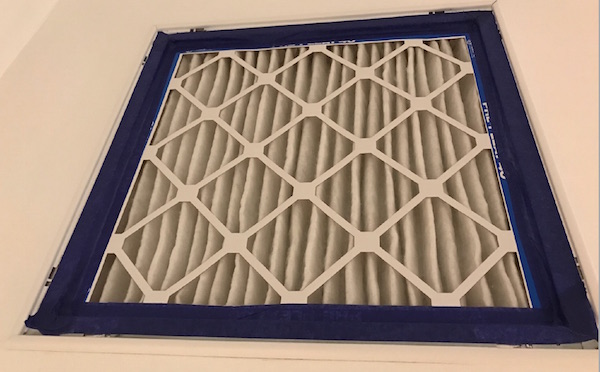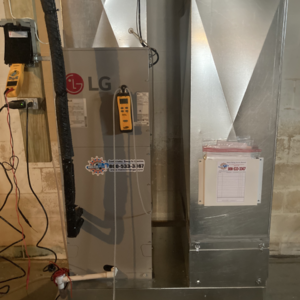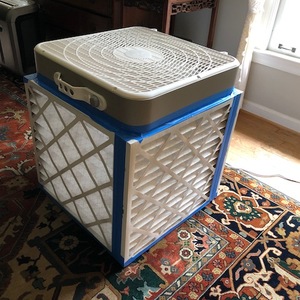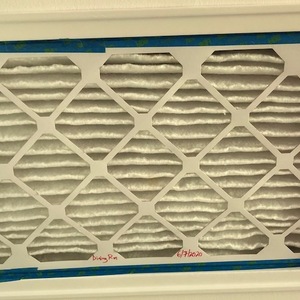
Last August I began a series of articles on filtration and indoor air quality. You can find them listed in the related articles section but let’s do a quick review here: We spend a lot of our time in buildings. A lot of indoor pollutants are generated in the kitchen and not removed by the range hood. The consensus among indoor air quality researchers is the particulate matter that’s 2.5 microns or smaller (PM2.5) is one of the worst for health. And finally, good filters (i.e., MERV-13) can remove a lot of the PM2.5 and other pollutants but experience as well as studies show they often don’t, for a variety of reasons.
So how do we fix this situation? How can we get a high-MERV filter and have it do a good job of filtration without causing problems with the airflow in the heating and cooling system? The answer is simple: Make the filter big enough. John Semmelhack, owner of building science firm Think Little in Virginia, spoke about this topic last year at the North American Passive House Conference in Boston. Also last year, we got a new Mitsubishi ducted minisplit system here in the Energy Vanguard office in Georgia (meticulously installed by PV Heating and Air). Let me show you what’s possible.
High-MERV filters with low pressure drop
Semmelhack spoke about ducted minisplit heat pumps in Boston and towards the end of his talk he got to the topic of filtration. (Download the presentation and see the filter section starting with Slide 25.) He used a 2-inch deep MERV-13 filter in a filter grille. The ducted minisplit they used was a one-ton system moving 400 cubic feet per minute (cfm) of air. The pressure drop across the MERV-13 filter was 0.0274 inch of water column. Yes, really!
What was their secret? They used a 20″ x 20″ filter. That’s all. Just make the filter bigger and you get a lower pressure drop. The key is to look at the ratio of the filter area to the airflow rate. In their case, the filter area was 2.78 square feet (sf) so the ratio comes out to be 2.78 sf ÷ 400 cfm = 0.007 sf/cfm. Using the nominal air flow rate of 400 cfm/ton of capacity, we can make the number look a little friendlier: 2.78 sf ÷ 1 ton = 2.78 sf/ton.
Hang onto that calculation. I’ll come back to it in a minute.

The Air Conditioning Contractors of America (ACCA) Manual J load calculation protocol says to allow 0.10 i.w.c for a filter… and that’s generally for a standard 1-inch-deep MERV-2 filter, not a 2-inch or 4-inch MERV-13. Ask contractors what the pressure drop across a MERV-13 filter is and they’ll probably tell you something like 0.25 i.w.c.

The main difference between the two systems is that our filter cabinet is installed in the middle of the return duct, whereas Semmelhack used a filter grille. We installed a filter grille, too, and currently it doesn’t have a filter in it. We’ll be testing that at some point, though. Another difference between Semmelhack’s pressure drop and ours is that he used a 2-inch-deep filter and ours is 4 inches deep. We’ll keep measuring our pressure drop, and I hope that with more data, our average pressure drop will be lower.
But we’re still happy with 0.06 i.w.c. The key to whether it’s a good number or not is how well it fits in with the total pressure drop in the system compared to what’s allowed (the total external static pressure, or TESP). More on that in a future article.
A simple rule of thumb for low pressure drop across a high-MERV filter
I’ve shown you data from two MERV-13 filters now. Both are much lower than you’d measure across many of the MERV-13 filters installed in the wild, and I’ve given you the key to achieving similarly low pressure drops. It’s simply to increase the filter area relative the air flow rate.
The two systems described above had ratios of 2.8 sf/ton and 3.1 sf/ton. You don’t have to go that high, though. David Butler, an HVAC designer and frequent commenter here, said he uses 2 sf/ton as his guide.
Home performance contractor extraordinaire Mike MacFarland of Energy Docs in Redding, California does it a bit differently. He uses 250 feet per minute (fpm) as his absolute maximum face velocity for air moving across the filter but generally sticks to 200 fpm or lower. The conversion from face velocity (ft/min) to filter area per ton of capacity (sf/ton) is straightforward using the equation q = A x v. (You may recognize the product of area and velocity from the continuity equation for air flow.) The answer in this case is that 200 fpm = 2.0 sf/ton in this case, the same number David Butler uses. MacFarland designs for conventional heat pumps rated for 0.5 i.w.c. total external static pressure (TESP) and had never had a system come in at a TESP higher than 0.35 i.w.c., with most of them measuring 0.30 i.w.c. or less.
With smaller capacity minisplit heat pumps, getting filter sizes to 2.5 or 3.0 sf/ton isn’t that hard. With conventional systems, it’s not so easy. With a 2.5 ton system at 3.0 sf/ton, for example, you’d need 7.5 square feet of filter area, or a 30″x36″ filter, but you’d have a hard time finding one that size so you’d have to install two 18″x30″ filters. You can do it if you really want to, but if you use MacFarland’s rule of 2.0 sf/ton, the resulting 24″x30″ filter (or equivalent) is much easier to find space for and you can still get a low pressure drop.
So here’s your rule of thumb for filter sizing:
Filter Area = 2.0 square feet for each 400 cfm of air flow
Do that (and size your ducts properly) and you shouldn’t have to worry about high pressure drops across your filters… at least not when the filters are relatively clean.
________________________________________________________________________
Allison A. Bailes III, PhD is a speaker, writer, building science consultant, and the founder of Energy Vanguard in Decatur, Georgia. He has a doctorate in physics and is the author of a bestselling book on building science. He also writes the Energy Vanguard Blog. For more updates, you can subscribe to Energy Vanguard’s weekly newsletter and follow him on LinkedIn. Photos courtesy of author.
Weekly Newsletter
Get building science and energy efficiency advice, plus special offers, in your inbox.














0 Comments
Log in or create an account to post a comment.
Sign up Log in